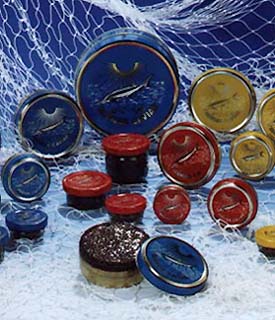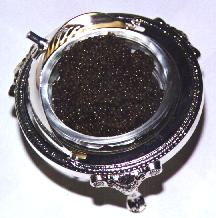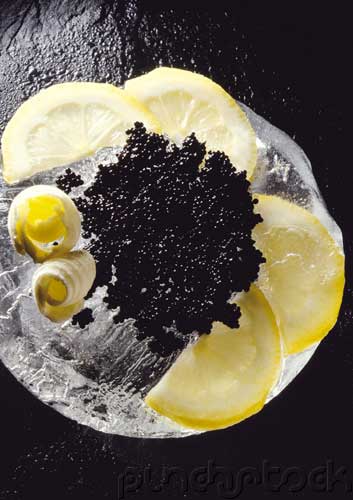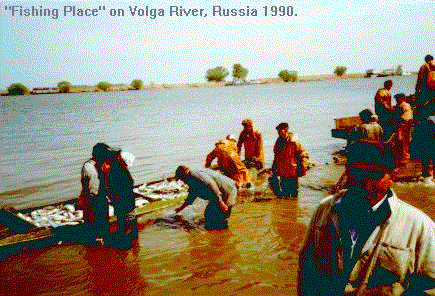
Legal Cluster
Bio-Geographic Cluster
Trade Cluster
Environment Cluster
Other Clusters
IRANIAN CAVIAR
 |
General
Information Legal Cluster Bio-Geographic Cluster Trade Cluster Environment Cluster Other Clusters |
M. Taghi Farvar, a Iranian environmental policymaker advises
that to curb the dwindling sturgeon population caviar producing states must
implement,“a very long moratorium on sturgeon fishing,
especially for the endangered species, at least for a couple of decades. CITES
must impose this long-term moratorium, or we must face the
more unpleasant option of losing some of the earth’s most wondrous evolution.”


|
|
|
|
|
|
|
|
|
 |
|||
 |
I. Identification |
1. The Issue
Caspian caviar was formerly monopolized by the Soviet Union and Iran, the only
two countries that flanked the Caspian Sea and thus, they controlled the supply
and price of caviar. Since the dissolution of the Soviet Union, however, there
are five countries that are eager to capitalize on caviar. Besides Iran, there
is Azerbaijan, Kazakhstan, Turkmenistan, Russia including its two Autonomous
Republics-Daghestan and Kalmykia. The increased desire to capitalize on caviar
exports has resulted in illegal overfishing which disregards environmental regulations
set by the Convention on International Trade in Endangered Species of Wild Fauna
and Flora (CITES). CITES seeks to regulate the population of endangered species
of sturgeons and has set export quotas to help sustain the sturgeon population.
The problem of poaching, however, continues to be particularly acute in all
littoral states, including Russia. Experts maintain that up to 90% of black
caviar sold in the Russian capital has been produced illegally. Although Iran
and the CIS are the primary sources of caviar in the international market, other
supposed exporters of caviar; such as Switzerland, Norway, Denmark, Sweden,
Iceland and Greenland do not differentiate between the roe of sturgeons and
that of other types of fish. In addition, many countries cited as the source
of caviar imports, mostly countries in the EU, may merely be re-exporting the
very caviar imported from Iran and the CIS.

2. Description
In today's market, caviar is among the most expensive
and exclusive of all preserved foods for several reasons: the mere scarcity of
the food because of over-fishing and pollution, the labor-intensive processing,
and its tendency to perish rapidly. Another reason that it is an exclusive and
thus costly product is because of the age and size a sturgeon must reach before
it develops its most valuable roe.


The sturgeon, the only fish whose roe can be classified as caviar under FDA rulings, is a prehistoric fish of almost 250 million years. There are around 25 different species and sub-species of sturgeons identified thus far, of which only three sturgeon species produce exquisite caviar: Beluga, Asetra, and Sevruga yielding over 90% of the world's total production (http://www.iran-export.com/exporter/company/shilat/). Beluga is the largest of the sturgeon family around 4 meters in length and 1000kg in weight. Beluga is very rare and thus only approximately 120 or less fish are caught each year. The roe of a beluga sturgeon is around 15% of its body weight, and its color varies from light gray to dark gray. The largest of the three types of roe, beluga roe has delicate skin, significant texture, and an apparent “eye” or point in the middle of each egg.

The oscetra, is less rare than the beluga and is a medium sized sturgeon measuring
2 meters in length and 200 kg in weight. Oscetra roe varies in color from dark
brown to gray and can often have shades of gold. The oscetra roe has a hint
of hazel nut and has a delicate skin-like surface.


Until 1966, any fish roe that could be colored black could be named as caviar. Thereafter, the Food and Drug Administration defined the product, and established guidelines for its labeling. The current labeling requirements indicate that:
The name 'caviar' unqualified may be applied only to the eggs of the sturgeon
prepared by a special process. Fish roe prepared from the eggs of other varieties
of fish and prepared by the special process for caviar must be labeled to show
the name of the fish from which they are prepared, for example ‘whitefish
caviar.’ All words in the name should be in type of substantially the
same size and prominence. If the product contains an artificial color, it must
be an approved color and its presence must be stated on the label conspicuously.
No artificial color should be used which makes the product appear to be better
or of greater value than it is. The label should bear a statement of ingredients
listed by their common or usual names in descending order of predominance because
no standard of identity has been established for any form of caviar” (Fishery
Products, US Food and Drug Administration, www.fda.gov/opacom/morechoices/smallbusiness/blubook/fishprod/htm).
Interestingly, there has been conflicting conceptions in the international market
as to what it means to be called 'caviar.' For example, in France, laws claim
that only processed roe of sturgeon can be termed as caviar. In the US, however,
various types of fish roe can be sold as 'caviar' as long as the fish type is
indicated on the packaging label. The US and other countries also produce 'caviar'
from the roe of salmon, paddlefish, whitefish and lumpfish. Each type of roe
has a different standard and the price is much lower than true caviar. For example,
the roe of salmon is classified by its firmness and juicyness and sells for
around $80 per kilogram versus $2,154 per kilogram for real caviar (http://www.ezcaviar.com/service/caviar_history_htm.htm.).
3. Related Cases: For Example,
4. Date: May 3, 2005 CITES has implemented export quotas in order to better regulate and maintain
a healthy sturgeon population. Iran, for example, has agreed with CITES to export
approximately 60,000 kg of caviar a year to protect the sturgeon population
from going extinct (http://www.cites.org/common/quotas/2005/sturgeon_quotas2005.pdf).
Although countries such as Canada, China, Romania, Turkey and the USA produce
caviar in small quantities, Iran and the CIS are the primary sources of caviar
on the international market. Also, some exporting countries that are cited as
exporters may not always be exporting true caviar. For example, Switzerland,
Norway, Denmark, Sweden, Iceland and Greenland do not differentiate between
the roe of sturgeons and that of other fish. All of these countries show inconsistent
prices in their statistics on "caviar" trade. In addition, many countries cited
as the source of caviar imports may simply be re-exporting caviar imported from
Iran and the CIS. CITES has helped to clarify important parts of the international
trade in sturgeon such as which species are meant for caviar and in what numbers,
the origin of the sturgeons ( wild, ranched or captive bred), and the countries
of origin, destination and re-export. In addition, by listing all sturgeons
under CITES, a confirmable conservation management system for harvesting and
exporting these precious fish, and for managing their international trade has
been installed. Additional benefits include the massive conservation attention
for sturgeons, and increased awareness amongst all stakeholders. European caviar
traders reported that the CITES listing of sturgeon has improved international
trade controls. They observed that since 1998 it has become easier to discriminate
legal from illegal sturgeon on the market, based on the presence or absence
of CITES documents. Also, dubious suppliers of caviar or caviar with questionable
origins have significantly diminished. Most importantly, there has been a heightened
awareness about the conservation status of the species and the need for strict
controls amongst suppliers, buyers and customs officials. 5. Discourse and Status: Allegation and Agreement
6. Forum and Scope: CITES and Multinational
7. Decision Breadth: Iran and other CIS countries
as well as countries with high imports of caviar
8. Legal Standing: In 1997 at the 10th Standing Committe
of CITES, the Committee determined close regulation of the international trade
of sturgeon, including all 23 species of Acipenseriformes listing it under Appendix
II ( a list of species that requires close regulation in order to prevent potential
endangerment. By April 1998, CITES established quotas for the international
trade of any product relating to sturgeon, including caviar.
9. Geographic Locations:
Iran, Russia, Azerbaijan and Kazakhstan supply about 90 % of the world's sturgeon
catch and caviar. The rest comes from China, Canada, Romania, the United States
and others.
a. Geographic Domain: Mideast
b. Geographic Site: Asia Mideast
c. Geographic Impact: Iran and the CIS
10. Sub-National Factors:
11. Type of Habitat: Sea 12. Type of Measure: Trade Ban.
CITES implemented export quotas that all members must adhere, to better regulate
the threatened sturgeon population. In addition, CITES implemented labeling
requirements that aim to deter illegal labeling of caviar products.
13. Direct v. Indirect Impacts: Direct
14. Relation of Trade Measure to Environmental Impact
a. Directly Related to Product: Yes, sturgeon
b. Indirectly Related to Product: Yes, roe
c. Not Related to Product: No
d. Related to Process: Yes, Species loss
15. Trade Product Identification: Caviar
16. Economic Data: In 2004, Iran exported a total
of 65 tons of caviar worth 35 million Euros.
17. Impact of Trade Restriction: Low
18. Industry Sector: Food
19. Exporters and Importers: Exporters- Iran and
CIS; Importers- EU, Japan, the United States and the United Arab Emirates.
20. Environmental Problem Type: Source- species loss
due to overfishing.
Of the over 24 types of Sturgeon species, only 3 types supply caviar: beluga,
osetra and sevruga. These caviar supplying fish are in danger of extinction
due to illegal overfishing and potential environmental damages to its population.
Interestingly in the last 20 years, sturgeon catches in the Caspian have dropped
from 20,000 tonnes in the late 1970s to just 550 tonnes in 2000. This great
plummet occurred despite an increase in fishing efforts in large part due to
illegal fishing and exporting of caviar. As a result, the sturgeon population
is in danger of extinction and the future of caviar is threatened. Therefore,
CITES has implemented export quotas in order to better regulate and maintain
a healthy sturgeon population. Iran, for example, has agreed with CITES to export
approximately 60,000 kg of caviar a year to protect the sturgeon population
from going extinct (http://www.cites.org/common/quotas/2005/sturgeon_quotas2005.pdf).
Another aspect that is attributing to sturgeons becoming endangered is that
approximately 90% of the Caspian sturgeons are killed before they mature (http://www.briancoad.com/Species%20Accounts/Acipenseridae.htm).
Consequently, the number of adult sturgeons in the Caspian Sea is estimated
to have dwindled by 70 percent, from 142 million adults in 1978 to 43.5 million
in 1994( http://ecolu-info.unige.ch/archives/envcee98/0115.html). The deteriorating
sturgeon population poses a threat to the trade of caviar in the world market.
The illegal trade and poaching of caviar negatively affects not only the future
of the species, but also the quality of caviar sold in the international market.
Illegal trade may result in the repackaging and false labeling of caviar which
fools the consumer into spending top dollar for an inferior product. 21. Name, Type, and Diversity of Species
Name: Sturgeon
Type:
Diversity:
IUCN Status: Vulnerable
22. Resource Impact and Effect: High and Scale.
23. Urgency and Lifetime: High and lifetime of fish
is approximately 100 years.
24. Substitutes: Other types of caviar. 25. Culture: Yes.
26. Trans-Boundary Issues: Yes, Caspian States
27. Rights: No
28. Relevant Literature: WEB:
http://www.traffic.org/publications/sturgeon_caviar.html http://www.cites.org/eng/resources/quotas/2002/sturgeon.shtml
IRANIAN
SAFFRON
TUNA
CASPIAN
STURGEON
THAI
SHRIMP
CAVIAR

II. Legal Clusters
Iran is not currently a member of the WTO, and consequently is not protected
under WTO regulations. Iran, however, does comply to the Convention on International
Trade of Endangered Species, a treaty protecting 30,000 animal and plant species
including sturgeon. The family of sturgeons, the basis of the multi-million
dollar caviar industry was added to the Convention on International Trade of
Endangered Species Appendix II, which allows for strictly managed international
trade. Sturgeons have been dangerously depleted in recent years due to pollution
as well as illegal overfishing. The CITES agreement gives the sturgeon range
States (including the Russian Federation, Iran, and other States bordering the
Caspian Sea) the tools and international support they need to regulate the international
caviar trade and to ensure its sustainablity.

III. Geographic Clusters

IV.Trade Cluster

V. Environmental Clusters

VI. Other Factors
http://www.payvand.com/news/04/may/1024.html
http://www.farsinet.com/caviar/faq.html
http://www.ezcaviar.com/service/caviar_history_htm.ht
http://www.iran-export.com/exporter/company/shilat/
http://www.iranexpert.com/2004/caviar7december.htm
http://www.azer.com/aiweb/categories/magazine/23_folder/23_articles/23_caviar.html
http://www.iran-export.com/exporter/company/shilat/"
http://www.american.edu/TED/saffron.ht
http://newsfromrussia.com/accidents/2004/05/04/53747.htm
http://www.caviaremptor.org/roe_to_ruin.PDF
http://www.briancoad.com/Species%20Accounts/Acipenseridae.htm